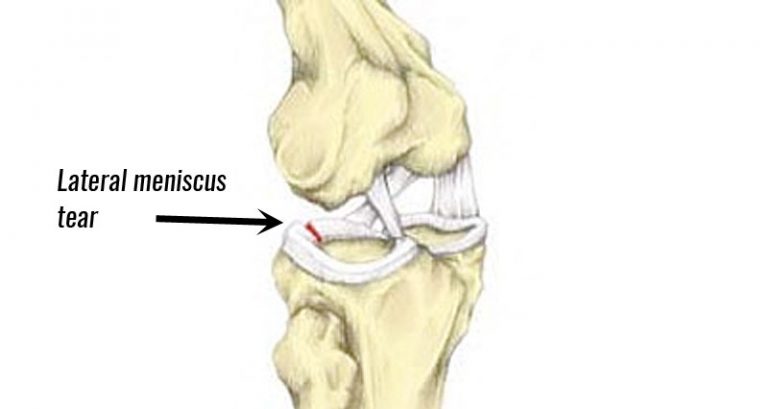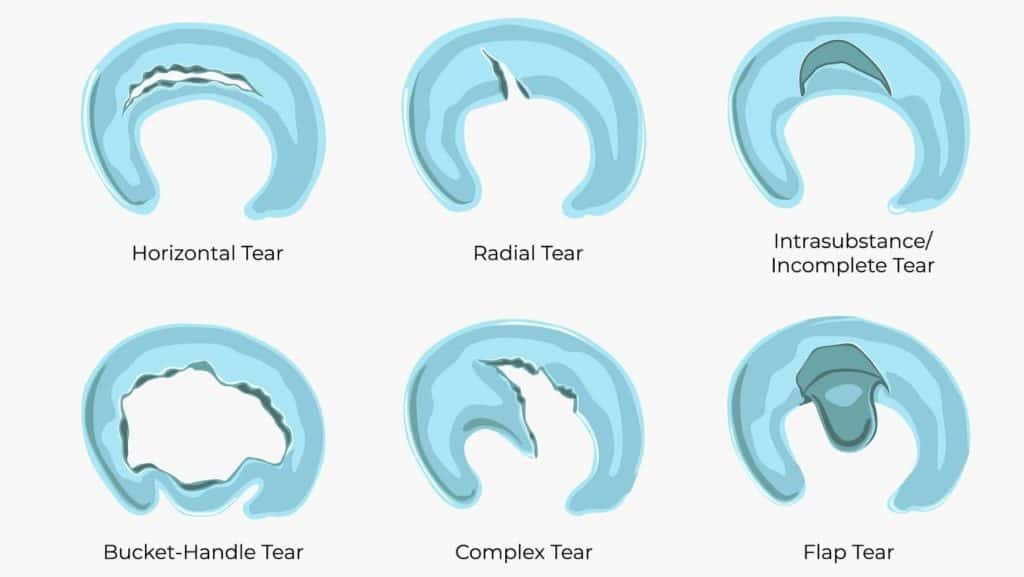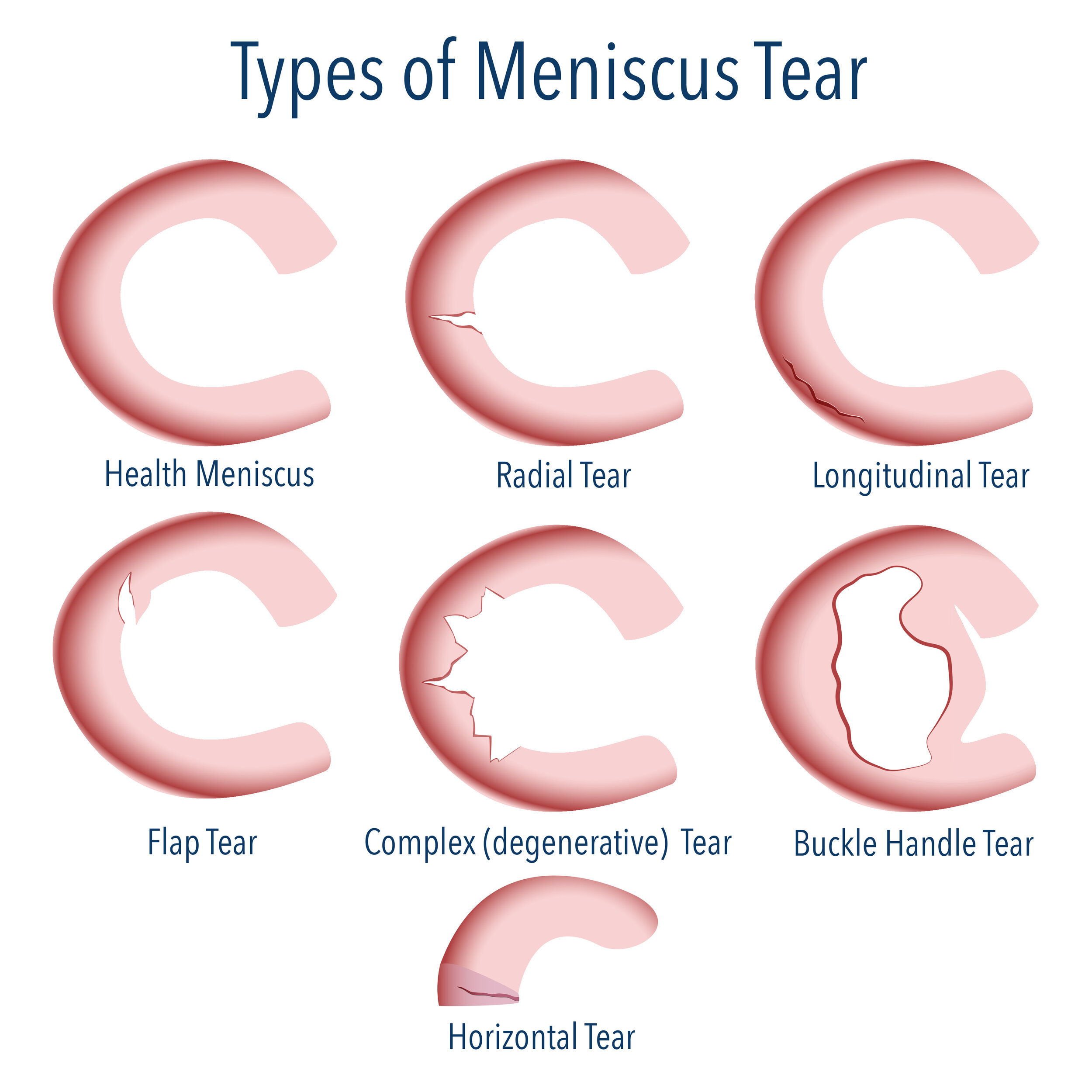Understanding Meniscus Tears

The meniscus is a C-shaped piece of cartilage that acts as a shock absorber between the thighbone (femur) and the shinbone (tibia) in the knee joint. It helps to distribute weight evenly across the knee joint, providing stability and cushioning during movement.
Anatomy and Function of the Meniscus
The meniscus is made up of two parts: the medial meniscus, located on the inner side of the knee, and the lateral meniscus, located on the outer side of the knee. Both menisci are attached to the knee joint capsule and help to:
- Distribute weight evenly across the knee joint.
- Provide stability and cushioning during movement.
- Prevent excessive wear and tear on the knee joint.
Types of Meniscus Tears
Meniscus tears can occur in different ways, depending on the type of injury.
- Horizontal Tear: This type of tear occurs across the width of the meniscus.
- Radial Tear: This type of tear runs from the outer edge of the meniscus to the inner edge.
- Oblique Tear: This type of tear runs diagonally across the meniscus.
- Degenerative Tear: This type of tear occurs due to wear and tear on the meniscus over time.
Causes of Meniscus Tears
Meniscus tears are often caused by sudden twisting or pivoting movements of the knee, especially when the foot is planted firmly on the ground. This type of injury is common in athletes, especially those who participate in sports that involve a lot of pivoting and twisting, such as basketball, football, and soccer.
- Sports injuries: Sudden twisting or pivoting movements during sports activities.
- Direct impact: A direct blow to the knee can also cause a meniscus tear.
- Degeneration: Wear and tear on the meniscus over time can lead to a tear.
Symptoms of Meniscus Tears
The symptoms of a meniscus tear can vary depending on the severity of the tear.
- Pain: A sharp pain in the knee, especially when twisting or bending the knee.
- Swelling: Swelling around the knee joint.
- Stiffness: Difficulty bending or straightening the knee.
- Clicking or popping: A clicking or popping sound in the knee when moving it.
- Locking: The knee may lock in place, making it difficult to move.
Prevalence of Meniscus Tears
Meniscus tears are a common injury, particularly among athletes and older adults. Studies have shown that the prevalence of meniscus tears can vary depending on the age group and activity level. For example, a study published in the “American Journal of Sports Medicine” found that the prevalence of meniscus tears in athletes was around 10%.
Impact of Meniscus Tears on Individuals
A meniscus tear can significantly impact an individual’s daily life, causing pain, stiffness, and difficulty with mobility. Depending on the severity of the tear, treatment options can range from conservative measures, such as rest, ice, and physical therapy, to surgery.
Diagnosis and Treatment Options: Meniscus Tear

Diagnosing and treating a meniscus tear involves a comprehensive approach, considering the severity and location of the tear, as well as the individual’s activity level and overall health.
Diagnostic Procedures, Meniscus tear
A thorough evaluation is crucial to determine the presence and extent of a meniscus tear. This typically involves a combination of the following procedures:
- Physical Examination: A doctor will assess the knee’s range of motion, stability, tenderness, and swelling. They will also perform specific maneuvers to test the meniscus, such as the McMurray test, which involves flexing and rotating the knee to check for a clicking or popping sound.
- Imaging Tests:
- X-rays: While X-rays cannot directly visualize the meniscus, they can rule out other conditions like fractures or arthritis.
- Magnetic Resonance Imaging (MRI): This is the gold standard for diagnosing meniscus tears, providing detailed images of the knee’s soft tissues, including the meniscus. An MRI can pinpoint the location, size, and type of tear, which helps guide treatment decisions.
Treatment Options
The treatment approach for a meniscus tear depends on factors like the tear’s location, size, and the patient’s symptoms and activity level.
Conservative Treatment
Conservative treatment aims to reduce pain and inflammation, allowing the tear to heal naturally. Options include:
- Rest: Avoiding activities that aggravate the knee, such as running or jumping, can give the meniscus time to heal.
- Ice: Applying ice packs to the injured area for 15-20 minutes at a time, several times a day, can help reduce swelling and pain.
- Compression: Using a compression bandage can help control swelling and provide support to the knee.
- Elevation: Keeping the leg elevated above the heart can also help reduce swelling.
- Over-the-counter pain relievers: Medications like ibuprofen or acetaminophen can help manage pain and inflammation.
- Physical therapy: Exercises to strengthen the muscles around the knee and improve flexibility can help improve stability and function.
Surgical Treatment
Surgery is usually considered when conservative treatment fails to alleviate symptoms or when the tear is severe.
- Arthroscopic Surgery: This minimally invasive procedure involves making small incisions in the knee and inserting a small camera and surgical instruments. The surgeon can then repair or remove the torn portion of the meniscus.
- Meniscectomy: In this procedure, the surgeon removes the torn portion of the meniscus. This is often performed for tears that are not repairable or for older individuals who are not very active.
- Meniscus Repair: This procedure involves stitching the torn portion of the meniscus back together. It is usually performed for tears that are located in a region of the meniscus that has a good blood supply, as this helps with healing.
Risks and Benefits
- Conservative Treatment:
- Benefits: Conservative treatment is generally safe and less invasive than surgery. It can be effective in relieving symptoms for many people, especially those with less severe tears.
- Risks: If the tear is not treated effectively, it can lead to further damage to the meniscus or surrounding tissues. It may also not be effective for all types of tears.
- Surgical Treatment:
- Benefits: Surgery can be effective in relieving pain and restoring function in cases where conservative treatment fails. It can also prevent further damage to the knee joint.
- Risks: As with any surgery, there are risks associated with arthroscopic surgery, including infection, bleeding, and damage to surrounding tissues. There is also a risk of complications, such as stiffness, pain, and instability.
Rehabilitation and Recovery

Recovering from a meniscus tear requires a structured rehabilitation program designed to restore knee function, reduce pain, and prevent future injuries. This program typically involves several stages, each with specific exercises and activities to promote healing and strengthen the knee joint.
Stages of Recovery
Rehabilitation for a meniscus tear usually follows a progressive approach, with each stage building upon the previous one. The duration of each stage may vary depending on the severity of the tear, individual factors, and the chosen treatment approach.
- Stage 1: Immediate Post-Surgery or Injury (First Few Days to Weeks)
- Stage 2: Early Rehabilitation (Weeks 2 to 6)
- Stage 3: Intermediate Rehabilitation (Weeks 6 to 12)
- Stage 4: Advanced Rehabilitation (Weeks 12 and Beyond)
Meniscus tear – The goal of this progressive approach is to gradually increase the load on the knee joint, promoting healing and strengthening the surrounding muscles. This helps restore normal knee function and minimize the risk of re-injury.
Physical Therapy
Physical therapy plays a crucial role in meniscus tear rehabilitation. A qualified physical therapist will design a personalized exercise program tailored to the individual’s needs and recovery progress.
Physical therapy aims to:
- Reduce pain and inflammation
- Improve range of motion
- Strengthen muscles around the knee
- Improve balance and coordination
- Increase functional activities like walking, running, and jumping
Physical therapists use various techniques and exercises, including:
- Range of Motion Exercises: These exercises help restore the full range of motion in the knee joint, reducing stiffness and improving flexibility. Examples include knee flexion, extension, and side-to-side movements.
- Strengthening Exercises: These exercises target the muscles around the knee, including quadriceps, hamstrings, and calf muscles. They help improve stability, control, and prevent further injury. Examples include squats, lunges, and leg presses.
- Proprioceptive Exercises: These exercises focus on improving balance and coordination, enhancing the body’s awareness of its position in space. Examples include standing on one leg, walking on uneven surfaces, and balance board exercises.
- Functional Exercises: These exercises simulate real-life activities, preparing the individual for everyday tasks and sports. Examples include walking, jogging, stair climbing, and jumping.
Physical therapy is essential for a successful recovery from a meniscus tear. It helps individuals regain strength, flexibility, and function in their knee joint, allowing them to return to their desired activities with confidence.
You know that squishy, C-shaped cartilage in your knee? Yeah, the meniscus. It’s a real party animal, cushioning your joints and keeping things smooth. But sometimes, it gets a little too enthusiastic and tears. If you’re experiencing knee pain, swelling, or clicking, it might be time to check out meniscus tear information.
Don’t worry, you can still get back to your favorite activities, even if your meniscus needs a little TLC.
A meniscus tear, ouch! That’s like a tiny, squishy shock absorber in your knee going “poof!” It can happen with a sudden twist or a forceful impact, just like a Gibbs injury might happen with a misplaced step on the ice.
But unlike a Gibbs injury, a meniscus tear usually doesn’t involve a broken bone, just a bit of a tear in the cartilage. So, rest, ice, and maybe some physical therapy are the usual suspects for healing.
